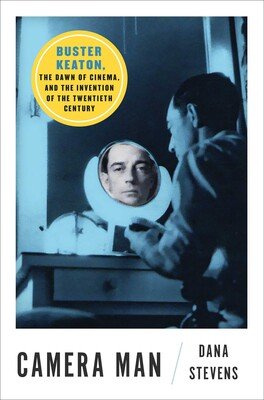Join us for a morning of hilarious movies, and the creation of something totally unexpected!
Special guest Dana Stevens, author of Camera Man, a highly acclaimed new biography on Buster Keaton, joins Devin Graham, a Kansas City expert in creative play, to conjure a project worthy of vaudeville’s ingenuity— open to chance and to people of all ages.
A couple of Keaton’s earliest short movies, The Scarecrow and One Week with LIVE ACCOMPANIMENT by Marvin Faulwell, will be followed by a multi-age, multi-arts creative studio and the wild-at-heart culture critic, Dana Stevens, will be around sign books and talk about Buster!
This is a wonderful event for ALL AGES!
Children must be accompanied by an adult for the duration of the event.
THIS EVENT IS FREE TO THE PUBLIC, BUT RESERVATIONS ARE REQUIRED as seating is limited.
Your reservation for A CELEBRATION FOR ALL AGES includes:
Screening of two Buster Keaton short films: The Scarecrow (20 minutes) and One Week (20 minutes).
A movie-themed creative studio with activities to entertain and inspire!
In her recent book, Camera Man: Buster Keaton, The Dawn of Cinema and the Invention of the Twentieth Century, culture maven and movie critic Dana Stevens explores the unstoppably creative society that transformed early movies into the American film industry. Deftly directing a wide literary lens, Stevens views seven decades of cultural history through the constantly moving figure of vaudeville star, stunt person, movie actor, producer, director and camera man, Buster Keaton.
Camera Man: Buster Keaton, the Dawn of Cinema and the Invention of the Twentieth Century will be available for purchase and signing!
American comedian, actor and filmmaker, Buster Keaton, was born in 1895 into a world of performance art and stage improvisation, where adults and kids worked and played together to put bread on the table but also to make people laugh! We aren’t exactly celebrating child labor, but we do want our Keaton fest to invite folks of all ages to play, laugh, and make stuff together!
In her highly acclaimed new book, Camera Man: Buster Keaton, the Dawn of Cinema and the Invention of the Twentieth Century, Dana Stevens explores Buster as a figure through which to see the rise of cinema and understand modern culture. Never was a historical figure’s childhood more clearly linked to his adult life and his effect upon others. Steven’ chronicles how, as a little boy, Buster captured the attention of critics across America with “his unaffected playfulness and curiosity as well as his virtuosic skill.” The critics’ appreciation, Stevens writes, “had a certain double-edged quality: from the beginning they experienced [Keaton] as both an accomplished, adult-level performer and a ‘natural,’ freely playing child.”
MARVIN FAULWELL
Marvin Faulwell is a very accomplished theatre organist. He has played for all previous Kansas Silent Film Festivals and our “sister project,” Silents in the Cathedral, held at Grace Cathedral in Topeka. He has appeared "in concert" and accompanied silent film programs in Iowa, Nebraska, Kansas, Missouri and Minnesota. He also accompanied many silent films shown at the Granada Theatre in Kansas City, Kansas.
The Modern Silent Film Accompanist
On a grey December day I walked to the mailbox and found a slim packet of DVDs from Bill Shaffer, planner of the Kansas Silent Film Festival. It was my assignment to accompany these films at the Kansas Silent Film Festival, an event to be held the last week in February, 2022. I then began scoring: a job I enjoy very much. I feel like I am part of the movie-making process. My procedure is to grab a cup of coffee, then insert the first film into the DVD Player. I make sure I don’t have a pen or paper in hand during this first run-through; otherwise I will start taking notes and miss the feel of viewing the film. The second time through I will make a cue sheet with timings for sound effects and begin to think about music…
At this point I need to share my philosophy about silent film accompaniment. I like to use music written for silent films by composers of the day—never modern popular music. Some of my favorite composers are: J. S. Zamecnik, Joseph Carl Breil, Irene Berg, Otto Langley, and William Ax. Later day composers like Lee Erwin and now Nathan Avakin provide very good music also. Most of this is incidental music: danger, chase, romance, etc. I have few complete scores. I try to respond to the action with appropriate music, and plan to use some needed sound effects (such as a ringing telephone on-screen). Once I have picked out the music I paste it and the movie action “cue sheet” in a large artist’s sketch pad. I currently have seven pads, with notes for about 20 films per pad.
I will usually travel to White Recital Hall at Washburn University in Topeka, Kansas a day before the start of the Festival. I must set up the organ, in this case the organ is a Reuter. The fact is: I rarely get to play a theater organ. I have played at Washburn for 25 years and at the “Silents In the Cathedral” event at Grace Cathedral, also in Topeka, for 24 years. I also play the wonderful Robert Morton organ in the Kansas City Music Hall in downtown Kansas City, Missouri about once a year. When I’m asked to play at smaller theaters I take a Kurzweil PC88 studio keyboard with me. I often also have a percussionist with me. (Bob Keckeisen is essential for providing special sound effects for war and gangster movies.)
Here is a history of silent film accompaniment.
Back at the turn of the Twentieth century films were shown in storefronts, lodge halls, and wherever else space was available (usually in noisy places). Music then was used to cover up the noise. Until Bronco Billy Anderson starred in The Great Train Robbery in 1903 there were no movie plots, and any music would do. Studios left it to the exhibitors to supply the accompaniment. This method changed when D. W Griffith directed Birth of a Nation in 1916. He hired Joseph Carl Breil to do a score, which was well-received by moviegoers. After this, accompaniment became very important and musical scores were sent out with the films. Today Breil is known to theatre organ enthusiasts for composing “The Perfect Song.”
How did organs become a part of this story? Americans loved the moving pictures and theaters flourished and got larger and larger. Soon the piano would no longer provide a strong enough volume for the music needed. With the choice of piano no longer viable, theaters were left the choice of hiring an organist and/or an orchestra.
Let’s look at the orchestra first: New film prints with synchronized scores flowed to the large first-run theaters. They used large orchestras with conductors, music librarians, and well-trained musicians.
But…if a film broke and footage was lost…they needed a team to alter the music to match the shortened timing of the movie. Also, when the film moved to smaller venues, the scores may not match and some of the music might be lost. Small orchestras had a harder time keeping up with needed edits in fragile movie film.
The larger theaters had both orchestra and organ options, and musicians could relieve each other. But an organist had the advantage. He or she was cheaper than a full orchestra, and could more easily adjust accompaniment to lost music or broken-and-repaired films. Also, with an organ, only one musician had to show up for the performance. An Art Form was born!
Classical organs were used at first, but the invention of the electro pneumatic action by Robert Hope Jones moved the console away from the pipes and the “theatre organ” was born…providing accompaniment as a single-unit-orchestra. The new sound became very popular. (“Gee, Dad, it’s a Wurlitzer!”)
These organs enjoyed a short life span before “talkies” came along and silenced them. Today there is a resurgent interest in classic silent films with organ accompaniment. Concert venues and home installations have revived the Theatre Organ…and it sings again!
I’m proud to carry on this tradition of silent film accompaniment in today’s live venues…performing live organ music for silent movie showings! – Marvin Faulwell, Lee’s Summit, Missouri
Faulwell began accompanying silent films in the 1980s at the Granada Theater in Kansas City, Kansas. For the past 25 years he has been accompanist at the Kansas Silent Film Festival at Washburn University in Topeka, Kansas and at “Silents In the Cathedral,” an annual Autumn event at Grace Cathedral, Topeka, Kansas. He has also played at the Keaton Celebration in Iola, Kansas, at the Scottish Rite in St. Louis, Missouri, and at The Music Hall in downtown Kansas City, Missouri.
For the first two full-day KSFF events in 1997 and 1998, Marvin Faulwell was our primary musician. During those first events, he played for almost twelve hours straight! He had one break for one short feature in the afternoon, but otherwise every short and every feature was played consistently by Marvin Faulwell. The KSFF team will forever salute him! - Bill Shaffer, KSFF Director





